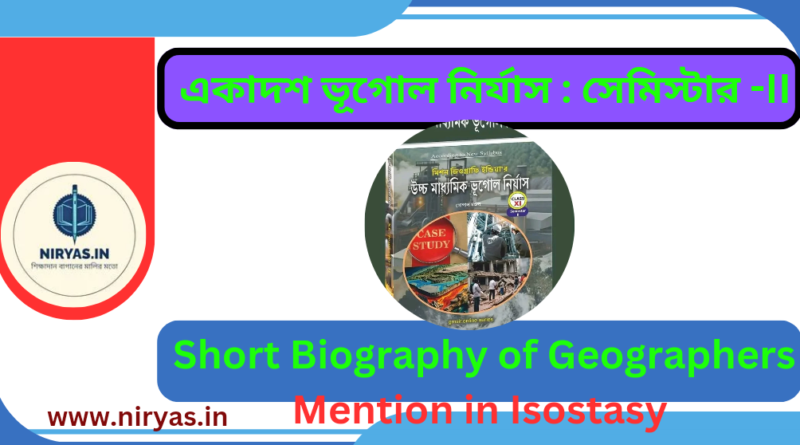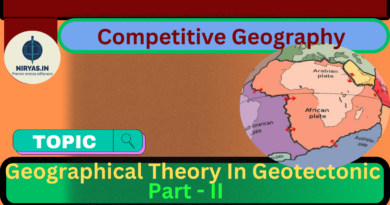Short Biography of Geographers Mention in Isostasy Chapter
Short Biography of Geographers Mention in Isostasy Chapter
The Higher Secondary Geography Syllabus has been changed. According to the new syllabus, the entire Higher Secondary Geography has been divided into four semesters, where two semesters are included in class XI and two semesters in class XII. Based on the new syllabus of Higher Secondary Geography, we are introducing the XI Geography Niryas : Second Semester section to discuss the semester-based content of Geography. In this section, we will now discuss the short biographies of various geographers mentioned in the Concept of Isostasy chapter of Unit-I of Physical Geography of class XI, second semester. So without waiting any longer, let’s read the Short Biography of Geographers post ➦
Short Biography of Geographers
1. Pierre Bouguer : French mathematician and physicist who made significant contributions to the study of optics and the behavior of light.
⦾ Born: February 16, 1698, Le Croisic, France
⦾ Died: August 15, 1758, Paris, France
⦾ Career: Mathematician, Physicist
⦾ Significant work: “Traité du Navire” (Treatise on Ships)
⦾ Best known for: Bouguer’s work on the behavior of light and his contributions to the development of naval architecture
⦾ Important books: “Traité du Navire” (Treatise on Ships), “Mémoire sur la gradation des couleurs” (Memoir on the Gradation of Colors)
⦾ Contribution to Isostasy : Proposed the concept of isostasy in his book “La Figure de la Terre” (1749), suggesting that the Earth’s crust floats on a denser mantle.
⦾ Eventually: Bouguer’s work on the behavior of light and his contributions to naval architecture demonstrate his dedication to scientific inquiry and his desire to apply mathematical principles to real-world problems.
2. Isaac Newton : English mathematician, physicist, and scientist who is widely recognized as one of the most influential scientists in history, known for his laws of motion and universal gravitation.
⦾ Born: January 4, 1643, Woolsthorpe, England
⦾ Died: March 31, 1727, Kensington, England
⦾ Career: Mathematician, Physicist, Astronomer
⦾ Significant work: “Philosophiæ Naturalis Principia Mathematica” (Mathematical Principles of Natural Philosophy)
⦾ Best known for: Newton’s laws of motion and universal gravitation
⦾ Important books: “Philosophiæ Naturalis Principia Mathematica” (Mathematical Principles of Natural Philosophy), “Opticks”
⦾ Contribution to Isostasy : Laid the foundation for isostasy with his law of universal gravitation (1687).
⦾ Eventually: Newton’s work on calculus, optics, and physics revolutionized our understanding of the natural world and had a profound impact on the development of modern science.
Short Biography of Geographers
3. Robert Hooke : English natural philosopher, architect, and polymath who made significant contributions to the study of physics, chemistry, and biology.
⦾ Born: July 18, 1635, Freshwater, England
⦾ Died: March 3, 1703, London, England
⦾ Career: Natural Philosopher, Architect, Polymath
⦾ Significant work: “Micrographia” (illustrated book on microscopy)
⦾ Best known for: Hooke’s work on microscopy, his discovery of cells, and his contributions to the development of modern science
⦾ Important books: “Micrographia” (illustrated book on microscopy)
⦾ Contribution to Isostasy : Proposed the concept of seafloor spreading and continental drift, influencing isostasy research.
⦾ Eventually: Hooke’s curiosity and passion for learning drove him to excel in various fields, from microscopy to architecture. His work continues to inspire and influence people around the world.
Short Biography of Geographers
4. John Henry Pratt : British mathematician and clergyman who made significant contributions to the study of mathematics and was a fellow of the Royal Society.
⦾ Born: June 4, 1809, London, England
⦾ Died: December 28, 1871, Ghazipur, India
⦾ Career: Mathematician, Clergyman
⦾ Significant work: “The Mathematical Principles of Mechanical Philosophy” (book)
⦾ Best known for: Pratt’s work on mathematics and his contributions to the development of modern mechanics
⦾ Important books: “The Mathematical Principles of Mechanical Philosophy” (book)
⦾ Contribution to Isostasy : Introduced the concept of “Pratt’s hypothesis” (1855), proposing that the Earth’s crust is in hydrostatic equilibrium.
⦾ Eventually: Pratt’s work on mathematics demonstrates his dedication to scientific inquiry and his desire to advance our understanding of the natural world.
5. Clarence Edward Dutton : American geologist and physicist who made significant contributions to the study of geology and physics.
⦾ Born: May 15, 1841, Wallingford, Connecticut, USA
⦾ Died: January 4, 1912, Englewood, New Jersey, USA
⦾ Career: Geologist
⦾ Significant work: “Tertiary History of the Grand Cañon District” (book)
⦾ Best known for: Dutton’s work on geology, particularly his studies on the Grand Canyon and his contributions to the development of modern geology
⦾ Important books: “Tertiary History of the Grand Cañon District” (book)
⦾ Contribution to Isostasy : Developed the theory of isostasy further, introducing the concept of “Dutton’s hypothesis” (1889).
⦾ Eventually: Dutton’s work on geology demonstrates his dedication to scientific inquiry and his desire to advance our understanding of the natural world.
Short Biography of Geographers
6. George Biddell Airy : British mathematician and astronomer who made significant contributions to the study of mathematics and astronomy.
⦾ Born: July 27, 1801, Alnwick, England
⦾ Died: January 2, 1892, Greenwich, England
⦾ Career: Mathematician, Astronomer
⦾ Significant work: “On the Algebraic and Numerical Theory of Errors of Observations and the Combination of Observations” (book)
⦾ Best known for: Airy’s work on mathematics and astronomy, particularly his studies on errors of observations and the combination of observations
⦾ Important books: “On the Algebraic and Numerical Theory of Errors of Observations and the Combination of Observations” (book)
⦾ Contribution to Isostasy : Proposed the “Airy-Heiskanen model” (1855), describing the Earth’s crust as a series of floating blocks.
⦾ Eventually: Airy’s work on mathematics and astronomy demonstrates his dedication to scientific inquiry and his desire to advance our understanding of the natural world.
7. Weikko Aleksanteri Heiskanen : Finnish geodesist and physicist who made significant contributions to the study of geodesy and physics.
⦾ Born: July 2, 1898, Tampere, Finland
⦾ Died: October 23, 1952, Helsinki, Finland
⦾ Career: Geodesist, Physicist
⦾ Significant work: “New Theory of the Earth’s Gravity Field” (book)
⦾ Best known for: Heiskanen’s work on geodesy and physics, particularly his studies on the Earth’s gravity field
⦾ Important books: “New Theory of the Earth’s Gravity Field” (book)
⦾ Contribution to Isostasy : Refined the Airy-Heiskanen model, developing the “Heiskanen-Hayford model” (1959).
⦾ Eventually: Heiskanen’s work on geodesy and physics demonstrates his dedication to scientific inquiry and his desire to advance our understanding of the natural world.
8. John Fillmore Hayford : American geodesist and physicist who made significant contributions to the study of geodesy and physics.
⦾ Born: May 19, 1868, Rouses Point, New York, USA
⦾ Died: March 10, 1925, Evanston, Illinois, USA
⦾ Career: Geodesist, Physicist
⦾ Significant work: “The Figure of the Earth” (book)
⦾ Best known for: Hayford’s work on geodesy and physics, particularly his studies on the Earth’s figure
⦾ Important books: “The Figure of the Earth” (book)
⦾ Contribution to Isostasy : Applied isostasy to geological problems, studying the Earth’s gravity field.
⦾ Eventually: Hayford’s work on geodesy and physics demonstrates his dedication to scientific inquiry and his desire to advance our understanding of the natural world.
Short Biography of Geographers
9. William Bowie : American geodesist and physicist who made significant contributions to the study of geodesy and physics.
⦾ Born: May 6, 1872, Annapolis, Maryland, USA
⦾ Died: August 25, 1940, Washington, D.C., USA
⦾ Career: Geodesist, Physicist
⦾ Significant work: “The Gravity Field of the Earth” (book)
⦾ Best known for: Bowie’s work on geodesy and physics, particularly his studies on the Earth’s gravity field
⦾ Important books: “The Gravity Field of the Earth” (book)
⦾ Contribution to Isostasy : Conducted extensive research on isostasy, developing new methods for gravity measurements.
⦾ Eventually: Bowie’s work on geodesy and physics demonstrates his dedication to scientific inquiry and his desire to advance our understanding of the natural world.
10. Reginald Aldworth Daly : Canadian-American geologist who made significant contributions to the study of geology and was a prominent figure in the development of modern geology.
⦾ Born: March 18, 1871, Napanee, Ontario, Canada
⦾ Died: September 19, 1957, Cambridge, Massachusetts, USA
⦾ Career: Geologist
⦾ Significant work: “Igneous Rocks and Their Origin” (book)
⦾ Best known for: Daly’s work on geology, particularly his studies on igneous rocks and their origin
⦾ Important books: “Igneous Rocks and Their Origin” (book)
⦾ Contribution to Isostasy : Studied isostasy in relation to mountain building and continental drift.
⦾ Eventually: Daly’s work on geology demonstrates his dedication to scientific inquiry and his desire to advance our understanding of the natural world.
Short Biography of Geographers
11. Arthur Holmes : British geologist who made significant contributions to the study of geology and was a key figure in the development of modern geology.
⦾ Born: January 14, 1890, Hebburn, England
⦾ Died: September 20, 1965, London, England
⦾ Career: Geologist
⦾ Significant work: “The Age of the Earth” (book)
⦾ Best known for: Holmes’ work on geology, particularly his studies on the age of the Earth
⦾ Important books: “The Age of the Earth” (book)
⦾ Contribution to Isostasy : Integrated isostasy into his theory of mantle convection and plate tectonics.
⦾ Eventually: Holmes’ work on geology demonstrates his dedication to scientific inquiry and his desire to advance our understanding of the natural world.
12. Leonardo da Vinci : Italian polymath and one of the most influential artists of all time, known for his work in art, science, engineering, mathematics, and anatomy.
⦾ Born: April 15, 1452, Vinci, Italy
⦾ Died: May 2, 1519, Amboise, France
⦾ Career: Polymath, Artist, Engineer, Mathematician
⦾ Significant work: “Mona Lisa,” “The Last Supper”
⦾ Best known for: Da Vinci’s iconic artwork, inventions, and scientific theories
⦾ Important books: “Codex Atlanticus,” “Codex Leicester”
⦾ Contribution to Isostasy : Mapped the Italian countryside, laying the groundwork for modern cartography.
⦾ Eventually: Da Vinci’s curiosity and passion for learning drove him to excel in various fields, from art to engineering. His work continues to inspire and influence people around the world.
Short Biography of Geographers
13. Edward McCurdy : British artist and writer who was known for his work on Leonardo da Vinci.
⦾ Born: 1871, London, England
⦾ Died: 1950, London, England
⦾ Career: Artist, Writer
⦾ Significant work: “Leonardo da Vinci” (biography)
⦾ Best known for: McCurdy’s biography of Leonardo da Vinci
⦾ Important books: “Leonardo da Vinci” (biography)
⦾ Contribution to Isostasy : Led expeditions to the American West, mapping and photographing landscapes.
⦾ Eventually: McCurdy’s work on da Vinci’s biography demonstrates his appreciation for the artist’s life and work.
14. Jacques Cassini : French astronomer and mathematician who made significant contributions to the study of astronomy and the measurement of the Earth’s circumference.
⦾ Born: February 8, 1677, Paris, France
⦾ Died: April 18, 1756, Thury, France
⦾ Career: Astronomer, Mathematician
⦾ Significant work: “Traité de l’astronomie” (Treatise on Astronomy)
⦾ Best known for: Cassini’s work on astronomy and his contributions to the development of modern astronomy
⦾ Important books: “Traité de l’astronomie” (Treatise on Astronomy)
⦾ Contribution to Isostasy : Measured the Earth’s meridian arc, contributing to geodesy.
⦾ Eventually: Cassini’s work on astronomy demonstrates his dedication to scientific inquiry and his desire to advance our understanding of the universe.
Short Biography of Geographers
15. Charles Marie de La Condamine : French mathematician, physicist, and explorer who made significant contributions to the study of mathematics, physics, and geography.
⦾ Born: January 28, 1701, Paris, France
⦾ Died: February 4, 1774, Paris, France
⦾ Career: Mathematician, Physicist, Explorer
⦾ Significant work: “Mesure des trois premiers degrés du méridien dans l’hémisphère austral” (Measurement of the First Three Degrees of the Meridian in the Southern Hemisphere)
⦾ Best known for: La Condamine’s work on the measurement of the Earth’s circumference and his contributions to the development of modern geography
⦾ Important books: “Mesure des trois premiers degrés du méridien dans l’hémisphère austral” (Measurement of the First Three Degrees of the Meridian in the Southern Hemisphere)
⦾ Contribution to Isostasy : Measured the Earth’s equatorial radius in Peru.
⦾ Eventually: La Condamine’s work on the measurement of the Earth’s circumference demonstrates his dedication to scientific inquiry and his desire to advance our understanding of the world.
16. Pierre-Louis Moreau de Maupertuis : French mathematician, physicist, and philosopher who made significant contributions to the study of mathematics, physics, and philosophy.
⦾ Born: July 17, 1698, Saint-Malo, France
⦾ Died: July 27, 1759, Basel, Switzerland
⦾ Career: Mathematician, Physicist, Philosopher
⦾ Significant work: “Discours sur les différentes figures des astres” (Discourse on the Different Figures of the Stars)
⦾ Best known for: Maupertuis’ work on the principle of least action and his contributions to the development of modern physics
⦾ Important books: “Discours sur les différentes figures des astres” (Discourse on the Different Figures of the Stars)
⦾ Contribution to Isostasy : Led an expedition to Lapland to measure the Earth’s polar radius.
⦾ Eventually: Maupertuis’ work on the principle of least action demonstrates his dedication to scientific inquiry and his desire to advance our understanding of the natural world.
Short Biography of Geographers
17. Sir Charles Lyell : British geologist who made significant contributions to the study of geology and was a key figure in the development of modern geology.
⦾ Born: November 14, 1797, Kinnordy, Scotland
⦾ Died: February 22, 1875, London, England
⦾ Career: Geologist
⦾ Significant work: “Principles of Geology” (book)
⦾ Best known for: Lyell’s work on geology, particularly his theory of uniformitarianism and his contributions to the development of modern geology
⦾ Important books: “Principles of Geology” (book)
⦾ Contribution to Isostasy : Developed the theory of uniformitarianism, shaping modern geology.
⦾ Eventually: Lyell’s work on geology demonstrates his dedication to scientific inquiry and his desire to advance our understanding of the natural world.
18. George Everest : British surveyor and geographer who served as the Surveyor-General of India and was responsible for the Great Trigonometric Survey of India.
⦾ Born: July 4, 1790, Gwernvale, Wales
⦾ Died: December 1, 1866, London, England
⦾ Career: Surveyor, Geographer
⦾ Significant work: “The Great Trigonometric Survey of India” (survey)
⦾ Best known for: Everest’s work on the Great Trigonometric Survey of India and his contributions to the development of modern geography
⦾ Important books: “The Great Trigonometric Survey of India” (survey)
⦾ Contribution to Isostasy : Surveyed the Indian subcontinent.
⦾ Eventually: Everest’s work on the Great Trigonometric Survey of India demonstrates his dedication to scientific inquiry and his desire to advance our understanding of the world.
Short Biography of Geographers
19. Jean-Étienne Guettard : French geologist and mineralogist who made significant contributions to the study of geology and mineralogy.
⦾ Born: September 22, 1715, Étampes, France
⦾ Died: January 7, 1786, Paris, France
⦾ Career: Geologist, Mineralogist
⦾ Significant work: “Mémoire sur les volcans” (Memoir on Volcanoes)
⦾ Best known for: Guettard’s work on geology and mineralogy, particularly his studies on volcanoes and minerals
⦾ Important books: “Mémoire sur les volcans” (Memoir on Volcanoes)
⦾ Contribution to Isostasy : Studied geological processes and mapped mineral deposits.
⦾ Eventually: Guettard’s work on geology and mineralogy demonstrates his dedication to scientific inquiry and his desire to advance our understanding of the natural world.
20. Alexander Buchan : British meteorologist and geographer who made significant contributions to the study of meteorology and geography.
⦾ Born: April 11, 1829, Kinnesswood, Scotland
⦾ Died: May 13, 1907, Edinburgh, Scotland
⦾ Career: Meteorologist, Geographer
⦾ Significant work: “The Climate of Scotland” (book)
⦾ Best known for: Buchan’s work on meteorology and geography, particularly his studies on the climate of Scotland
⦾ Important books: “The Climate of Scotland” (book)
⦾ Contribution to Isostasy : Researched climate patterns and ocean currents.
⦾ Eventually: Buchan’s work on meteorology and geography demonstrates his dedication to scientific inquiry and his desire to advance our understanding of the natural world.
Short Biography of Geographers
21. John Joly : Irish physicist and geologist who made significant contributions to the study of physics and geology.
⦾ Born: November 1, 1857, Bracknagh, Ireland
⦾ Died: December 21, 1933, Dublin, Ireland
⦾ Career: Physicist, Geologist
⦾ Significant work: “Radioactivity and Geology” (book)
⦾ Best known for: Joly’s work on radioactivity and geology, particularly his studies on the age of the Earth
⦾ Important books: “Radioactivity and Geology” (book)
⦾ Contribution to Isostasy : Studied geological processes and developed the theory of radioactivity.
⦾ Eventually: Joly’s work on radioactivity and geology demonstrates his dedication to scientific inquiry and his desire to advance our understanding of the natural world.
22. Blaise Pascal : French mathematician, physicist, and philosopher who made significant contributions to the study of mathematics, physics, and philosophy.
⦾ Born: June 19, 1623, Clermont-Ferrand, France
⦾ Died: August 19, 1662, Paris, France
⦾ Career: Mathematician, Physicist, Philosopher
⦾ Significant work: “Traité du triangle arithmétique” (Treatise on the Arithmetical Triangle)
⦾ Best known for: Pascal’s work on mathematics, physics, and philosophy, particularly his studies on probability and the development of the Pascaline calculator
⦾ Important books: “Traité du triangle arithmétique” (Treatise on the Arithmetical Triangle)
⦾ Contribution to Isostasy : Contributed to probability theory and geophysics.
⦾ Eventually: Pascal’s work on mathematics, physics, and philosophy demonstrates his dedication to scientific inquiry and his desire to advance our understanding of the natural world.
Short Biography of Geographers
23. Lester Charles King : South African geologist who made significant contributions to the study of geology and was a prominent figure in the development of modern geology.
⦾ Born: December 16, 1907, Johannesburg, South Africa
⦾ Died: September 2, 1989, Grahamstown, South Africa
⦾ Career: Geologist
⦾ Significant work: “The Morphology of the Earth” (book)
⦾ Best known for: King’s work on geology, particularly his studies on the morphology of the Earth
⦾ Important books: “The Morphology of the Earth” (book)
⦾ Contribution to Isostasy : Developed the theory of landscape evolution.
⦾ Eventually: King’s work on geology demonstrates his dedication to scientific inquiry and his desire to advance our understanding of the natural world.




